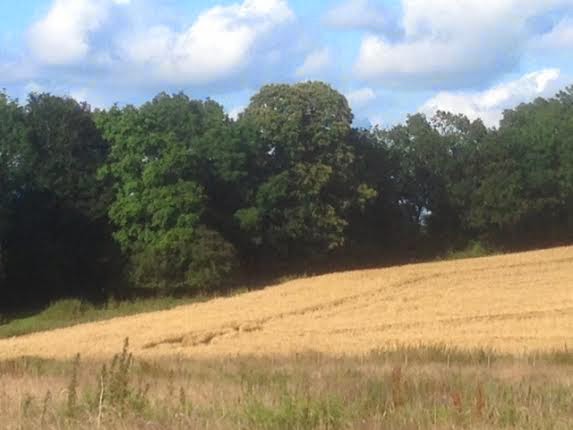Church of St Mary the Virgin, Llanfair Kilgeddin

The setting of this little church is beautiful, quiet and secluded, tucked away, surrounded by soft green countryside near the River Usk, up a small lane opposite the entrance to Pant-y-Goitre House which was the subject of my first post in this series.
A listed building, the original church dates from medieval times and was built on the site of a hermit's cell, the font is purported to be Norman and the chancel screen is 15th century. Extensive rebuilding was commissioned in 1875-76 by Rev. William John Coussmaker Lindsay who appointed architect John Dando Sedding to carry out the work incorporating the earlier structure. There is a twin bell tower and in the church yard are the remains of a late medieval cross to which Sedding added a new top.
Although open to the public, by arrangement, St Mary's Church is no longer used for regular services and is owned by the Friends of Friendless Churches.



Pretty as the exterior of St Mary's is, a true hidden gem lies within the tiny church itself. When you enter the church you cannot fail to be amazed by the series of truly wonderful Sgraffito panels which cover all the walls of the main church with illustrated texts from the Benedicite. The work was commissioned by Rev Lindsay to commemorate his wife Rosamund Emily Lindsay who had died in 1885. You can see the dedication of the work to Rosamund situated adjacent to the pulpit where Revd Lindsay preached as rector of the parish.



Pretty as the exterior of St Mary's is, a true hidden gem lies within the tiny church itself. When you enter the church you cannot fail to be amazed by the series of truly wonderful Sgraffito panels which cover all the walls of the main church with illustrated texts from the Benedicite. The work was commissioned by Rev Lindsay to commemorate his wife Rosamund Emily Lindsay who had died in 1885. You can see the dedication of the work to Rosamund situated adjacent to the pulpit where Revd Lindsay preached as rector of the parish.
The eminent Arts and Crafts artist Heywood Sumner was appointed to carry out the work and the artist's initials and date can be seen recorded on a roundel under the window depicting 'All Ye Beasts'. Sumner's father was Bishop of Winchester and his mother the founder of The Mother's Union. Sumner applied the Sgraffito technique to create the 16 beautiful art nouveau panels, using thin layers of different coloured plaster, allowed to dry and then cut back to reveal the colours underneath. His designs included local features, Sumner included local features in his designs - for example in 'O Ye Mountains and Hills' on the north wall of the nave the nearby River Usk, the Sugar Loaf and Llanvihangel Gobion church tower are all included. Sumner's work was completed in 1888.
.jpg)
In the 1980s, St Mary's Church was declared redundant and threatened with demolition, but thanks to the awareness raising actions of local residents, Roger Perkins and Maurice Trumper, was rescued and restored by the Friends of Friendless Churches charity, supported by the Victorian Society and with financial support from CADW and the Pilgrim Trust. The beautiful Sgraffito panels were threatened by cracking, crazing, bulging, staining and delamination caused by moisture and salt movement and a trapping of water between the brittle cement murals and the soft stone wall behind. The £70,000 restoration work involved an intricate programme of stabilisation and repairs to the three layer system, including grouting, micro-pinning and fine surface repairs.
More Information
Friends of Friendless Churches
Tel: 020 7236 3934
email: office@friendsoffriendlesschurches.org.uk
Contact details of key holders are on the board in the church porch or contact Friends of Friendless Churches above for keyholder details.
.jpg)
Details of some of the panels - too many to photograph individually
 |
| This panel 'Oh Ye Mountains and Hills' shows the nearby River Usk, Sugar Loaf and Blorenge and possibly Pen Cerrig Calch or could it be Pen-y-Fan painted in the far distance? |
In the 1980s, St Mary's Church was declared redundant and threatened with demolition, but thanks to the awareness raising actions of local residents, Roger Perkins and Maurice Trumper, was rescued and restored by the Friends of Friendless Churches charity, supported by the Victorian Society and with financial support from CADW and the Pilgrim Trust. The beautiful Sgraffito panels were threatened by cracking, crazing, bulging, staining and delamination caused by moisture and salt movement and a trapping of water between the brittle cement murals and the soft stone wall behind. The £70,000 restoration work involved an intricate programme of stabilisation and repairs to the three layer system, including grouting, micro-pinning and fine surface repairs.
Lovely countryside surounds St Mary's Church
More Information
Friends of Friendless Churches
email: office@friendsoffriendlesschurches.org.uk
Contact details of key holders are on the board in the church porch or contact Friends of Friendless Churches above for keyholder details.
How to find St Mary's Church Llanfair Kilgeddin
St Mary's Church is situated up a narrow lane running off the B4598 between Usk and Abergavenny. It is signposted opposite/ near the gates to Pant-y-Goitre House.
St Mary's Church is situated up a narrow lane running off the B4598 between Usk and Abergavenny. It is signposted opposite/ near the gates to Pant-y-Goitre House.



.jpg)
.jpg)
.jpg)

.jpg)













.jpg)











.jpg)
